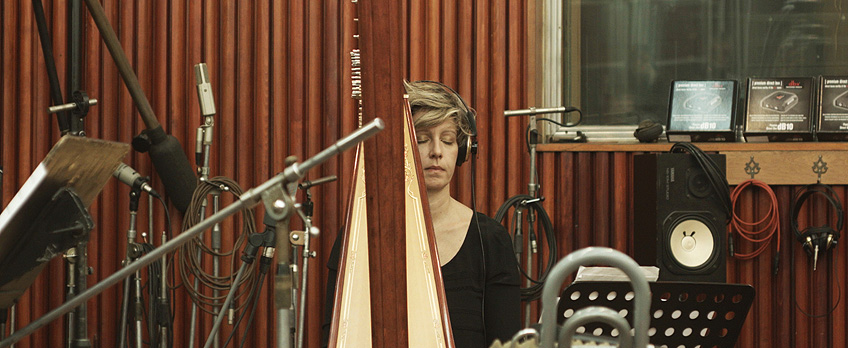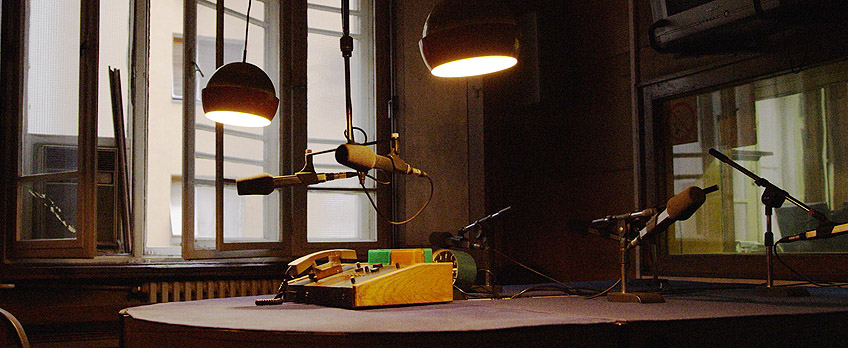Resonance and Remembrance: An Interview with Marija Stojnić

Speak So I Can See You is the debut documentary feature from Serbian director Marija Stojnić. It is an experimental homage to Radio Belgrade, one of the oldest radio stations in Europe, which has been on air for over 90 years. Stojnić’s film playfully mixes archival audio from Radio Belgrade – including scientific, musical and drama programs – with experimental sound to explore how radiophonic sound shapes the city’s public and private spaces.
Critics Campus participant Isabella Mahoney speaks to Stojnić about her personal relationship to Radio Belgrade, the power of archival voices, and escaping noise pollution during the pandemic.
Isabella Mahoney: Speak So I Can See You has been referred to as a “love letter to old-school radio” and a “paean to Radio Belgrade”. Can you speak about your personal relationship to this radio station?
Marija Stojnić: Radio has always been present in my life since I was a kid. Some of my first memories were sneaking into my parents’ bed and listening to the children’s morning show. When I was studying directing, we had a class that was directing for radio. The class was held in Radio Belgrade, and that’s when I first fell in love with the radio and [this] building. It really felt like a time capsule to me. It was so different from its surroundings. I like to say that it reminds me of a spaceship that travels through time and collects bits and fragments of our history and memory and collective experience in general.
Then I forgot about the radio for a little while and, in 2016, I came back to Belgrade and noticed how, every time I turned the radio on, I would hear and see the transformation of my space. I would feel my room transform, and then my perception, my thinking process. In a way, I reconnected to the city through the radio sound.
How do the people of Belgrade relate to this radio station, which has been running for almost 90 years? Has it always been a well-loved station?
It’s the only station in the country that still broadcasts old-school live, spoken-word, cultural, art, drama and science programming of its time, and definitely the only place that still does radio-drama production in-house. I think people are still very fond of it. No matter the circumstances, radio keeps moving on and preserving its quality, which I really think is amazing. I hope it will stay like that in the future.
What was it like to go through Radio Belgrade’s archival material to create the soundscapes in the film?
It was a long process – we filmed for almost three years. I was listening to the archives over that time and I think I heard around 1000 pieces in total. Around 50 segments ended up being in the film. It was a very interesting and playful process, and I had to let my intuition guide me into it. So if I got goosebumps and was struck by something I heard, I knew that I needed to pay attention to it. And it usually meant that it had some kind of connection with the contemporary world. It was interesting how some historical pieces resonate so strongly today.
I noticed your selection of audio references the art or philosophy of communication. And you use so many different voices that overlap.
From the beginning, the film was imagined as a puzzle, in a way, of fragments. We tried to embody it in one consistently changing voice of this giant: the radio. We imagined the radio as a conscious, fully aware giant with an in incredible historical memory. What would it say? How would it feel? What would its response be to the ‘now’? That was our process of selecting the material: trying to simulate this non-human but collectively human creature.

Speak So I Can See You
And the polyphony of voices in the film reflects the polyphony of the radio itself.
Yes, and human histories and stories. The archives still seem endless to me, and I’m so impressed with so much oral history that we’ll maybe never be able to hear again, but it’s preserved. It’s almost random what we get to hear again, you know?
Yes, and that speaks to the ideas in the film about truth and power. I’m interested in why you chose to mix the documentary mode and fiction, in relation to ideas of storytelling and truth.
I had a phenomenal professor, Deirdre Boyle at The New School in New York, who encouraged us to think about authenticity and claims of truth. There’s this term, ‘pornography of real’ – just because footage is authentic, it is supposed to represent some kind of truth. But we keep learning over and over that truth is very subjective, and sometimes can be manipulated. For me, there is no clear border between fiction and documentary. In everything I do, cinema is cinema; a film is a film. The way I perceive documentary is that it should present my personal truth – as an artist, as an observer – and I’m trying to stay faithful and true to what I actually feel and think.
Regarding the relationship between audio and visual – in the film, you show a woman reading a political bulletin. She’s holding her throat, and you can feel that her voice is strained, that it has a texture or grain. Then you cut to a scene with a female scientist working in a lab, listening to the radio. Is there a feminist element to your work, when it comes to showing women’s voices and women’s labour, which are typically more invisible than men’s?
There’s definitely a separation between male and female labour. It was interesting to me, for example, that there were way more male voices present in the archive. I somehow was thinking about making a balance, and I think it turned out to be a coincidence in this scene that there’s a female radio host and a female scientist. I wasn’t trying to do it consciously; it just felt right to do it that way.
In the film, ‘The Wanderer’ says he desires words to be “peaceful, obedient instruments”. You seem to be exploring how words can be used in misunderstandings and how it is impossible to have perfect communication.
I think we always struggle – there is no perfect communication. First of all, we are not able sometimes to communicate with ourselves. It’s hard to get to the point where you can be honest with yourself, at all times. I’m not even sure that’s possible, but it’s a skill that you have to cherish and work on constantly. It seems like a never-ending job for everyone, but I think it’s very important to invest time and effort in communication. Maybe it’s the biggest barrier and also the most powerful tool to connect us. I think this [current] situation where we are isolated more than ever shows us how vital it is, and it opens up many questions.
You include lines from Carl Sagan’s Cosmos in the film – for example, “We’re all connected to the cosmos.” Could you speak about how the radio is something that connects people, not only through the language of words but also through music?
Sometimes, only a few notes can take you to a completely different emotional and intellectual space, and a completely different intuitive space. I think that sound – not just words, but voice and music – are powerful forms of communication. We use experimental sound in the film to create atmospheres, pull the viewer into a magical world and inspire them to think about designing their own soundscapes.
What do you mean by “designing their own soundscapes”?
We are sometimes not aware of the sound pollution we are constantly exposed to. When you see an image that you don’t want to see, you simply look away, but you cannot ‘listen away’. Everything we hear now as we are talking – a bike passing, the music in my café, people behind me – is imminent and omnipresent. If you tune in to most media today, you hear content that you maybe wouldn’t necessarily choose to hear. It affects us.
But the programming of Radio Belgrade is very carefully crafted. There are no ads, so it feels so peaceful and clear. It helps you be with yourself and connect with others. It was interesting how the city went silent during the pandemic, in lockdown. To me, it was amazing having a few weeks without that much noise. It just made me feel way less anxious and more peaceful.
And there’s a spiritual aspect to this mindfulness.
Long story short: choose what you tune in to!